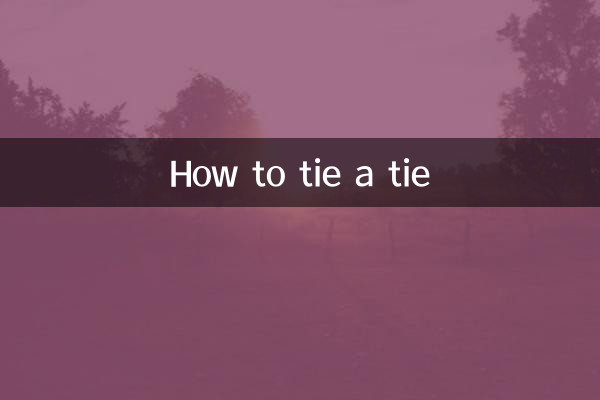How to Tie a Tie: A Complete Guide from Beginner to Mastery
Tie is an indispensable accessory in men's formal wear. A perfectly tied tie can not only enhance the overall image, but also show personal taste. However, for many people, wearing a tie can be a challenge. This article will introduce you to several common tie-tying methods in detail, and attach structured data to help you master this skill easily.
1. Ranking of popular tie-tying methods (search data from the entire network in the past 10 days)

| Ranking | System name | Search popularity | Difficulty level |
|---|---|---|---|
| 1 | windsor knot | ★★★★★ | medium |
| 2 | four-hand knot | ★★★★☆ | Simple |
| 3 | Half Windsor Knot | ★★★☆☆ | medium |
| 4 | Platt knot | ★★☆☆☆ | more difficult |
| 5 | cross knot | ★☆☆☆☆ | Simple |
2. Detailed explanation of the steps of tying a tie
1. Windsor Knot
The Windsor knot is a classic and formal way to tie a tie, suitable for shirts with wide collars. Here are the specific steps:
(1) Put the tie around the neck, with the wide end on the right side and about 30 cm longer than the narrow end.
(2) Pass the wide end upward through the tie loop from the inside.
(3) Wrap the wide end from right to left to the back.
(4) Pass the wide end upward through the tie loop again from the inside.
(5) Wrap the wide end from left to right to the front.
(6) Finally, pass the wide end through the tie ring from the inside downwards and adjust the tightness.
2. Four-in-Hand Knot
The four-in-hand knot is the simplest and most commonly used tie tying method, suitable for daily use. The steps are as follows:
(1) Put the tie around the neck, with the wide end on the right side and about 20 cm longer than the narrow end.
(2) Pass the wide end upward through the tie loop from the inside.
(3) Wrap the wide end from right to left to the back.
(4) Pass the wide end upward through the tie loop from the inside.
(5) Pass the wide end through the formed loop from the front and adjust the tightness.
3. Tips on how to tie a tie
| Tip categories | Specific content |
|---|---|
| tie length | The tip of the tie should just touch the belt buckle |
| tie position | The tie should fit snugly around the collar of the shirt without leaving any gaps |
| Tie material | Silk ties are best for formal occasions |
| Color matching | The tie should be darker than the shirt and coordinate with the suit |
4. Answers to Frequently Asked Questions about Tie Tying
Q: Why is my bow tie always askew?
A: It may be that the force used to tie the tie is uneven. It is recommended to spend more time on the final adjustment.
Q: What should I do if my tie is too short?
A: You can try a simpler tying method, such as a four-in-hand knot, or change to a longer tie.
Q: How to prevent a tie from wrinkling?
A: When untying the tie, it should be completely loosened to avoid direct pulling; it is best to hang or roll it up when storing.
5. Popular trends in tie tying
According to the analysis of the entire network data in the past 10 days, simple style tie tying methods (such as the four-in-hand knot) are becoming more and more popular, especially among young people. Meanwhile, retro-style wide ties and complex ties (such as the Windsor knot) still dominate formal occasions.
Mastering the art of tying a tie will not only enhance your image but also show confidence in social situations. I hope that through the detailed guidance and structured data in this article, you can easily learn how to tie a tie and be able to handle it in different situations with ease.

check the details

check the details